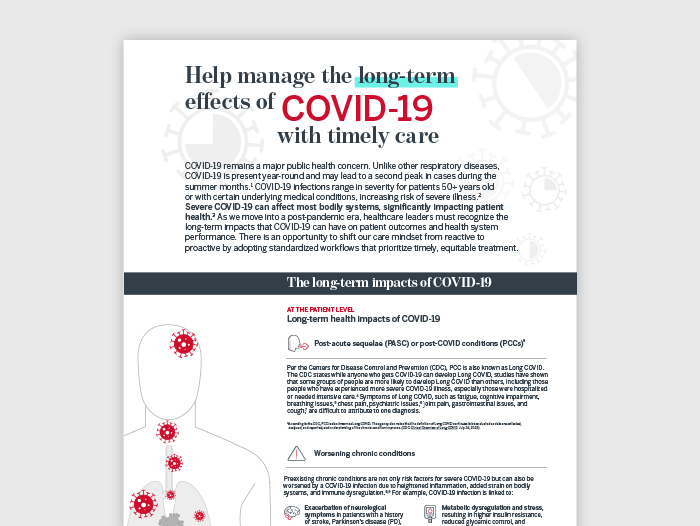Auto logout in seconds.
Continue LogoutCOVID-19 hospitalizations are still increasing nationwide, with CDC data showing over 20,000 new hospital admissions for the week ending Sept. 9. And as cases and hospitalizations continue to rise, researchers are keeping an eye on the highly mutated BA.2.86 omicron subvariant.
Where COVID-19 hospitalizations currently stand
For the week ending Sept. 9, there were 20,538 new COVID-19 hospitalizations nationwide — a 7.7% increase from the week before. According to ABC News, this is the first time COVID-19 hospitalizations have exceeded 20,000 since mid-March.
Overall, 19 states saw substantial increases (20%) in hospitalizations, and 12 states saw moderate increases (10% to 19.9%) for the week ending Sept. 9.
Although COVID-19 hospitalizations have increased in recent weeks, they are still much lower the numbers reported during the same period in years prior.
"Hospitalizations [are] still a fraction of where we were in last winter and last summer," said Dr. Peter Chin-Hong, an infectious diseases specialist at the University of California, San Francisco. "I think it's not surprising, but it's still not like before — in terms of a surge — overwhelming resources. However, it is a siren call for the winter, when we have other things that cause people to go to hospital as well."
According to Chin-Hong, the healthcare system could be strained this winter if COVID-19 hospitalizations keep increasing, especially with other viruses such as influenza and respiratory syncytial virus also expected to spread.
"If you bring too many people together and hospitalize them, it really strains the system and makes it hard for people who have other conditions to come into the hospital," Chin-Hong said.
So far, it's not clear how COVID-19 will trend in the coming weeks. Data from Biobot Analytics suggests that levels of COVID-19 in wastewater samples decreased by roughly 5% nationwide last week, but CDC data suggests that virus levels are increasing at more wastewater data sites.
Scientists continue to track BA.2.86
In August, the World Health Organization and CDC began monitoring a new omicron subvariant BA.2.86, nicknamed "Pirola." When it first emerged, many health experts were concerned about BA.2.86's potential to evade immunity from past vaccinations and infections. Compared to other circulating variants, BA.2.86 has more than 30 mutations to its spike protein, an area that is targeted by antibodies.
According to data from the global virus database GISAID, BA.2.86 has been identified in at least 10 U.S. states, including Colorado, Maryland, Michigan, New York, Ohio, Oregon, Pennsylvania, Texas, Virginia and Washington.
Currently data suggests that BA.2.86 currently makes up only a small portion of new COVID-19 cases in the United States. Although health authorities say that BA.2.86 is spreading widely worldwide, it is too soon to tell whether the subvariant will do the same in the United States.
So far, early research suggests that BA.2.86 is less immune-evasive than health experts initially believed and that both new vaccines and prior infection should effectively neutralize the subvariant.
"BA.2.86 actually poses either similar or less of an immune escape risk compared with currently circulating variants, not more," said Dan Barouch, who conducted a study on BA.2.86 at Beth Israel Deaconess Medical Center. "So that is good news. It does bode well for the vaccine."
To protect yourself from COVID-19 infection, health experts have encouraged eligible individuals to get a shot of an updated COVID-19 vaccine. FDA recently approved two new COVID-19 vaccines targeting the XBB.1.5 omicron subvariant from Moderna and Pfizer-BioNTech. CDC has also recommended all Americans ages 6 months and older receive at least one dose of the newest COVID-19 vaccine. (Tin, CBS News, 9/18; Duhon, The Hill, 9/19; Kekatos/Benadjaoud, ABC News, 9/19; CDC COVID-19 Data Tracker, accessed 9/22)
To help hospital leadership teams pressure test the comprehensiveness of their response and check for blind spots, we created this scenario planning guide in collaboration with health systems and internal experts.
Don't miss out on the latest Advisory Board insights
Create your free account to access 1 resource, including the latest research and webinars.
Want access without creating an account?
You have 1 free members-only resource remaining this month.
1 free members-only resources remaining
1 free members-only resources remaining
You've reached your limit of free insights
Become a member to access all of Advisory Board's resources, events, and experts
Never miss out on the latest innovative health care content tailored to you.
Benefits include:
You've reached your limit of free insights
Become a member to access all of Advisory Board's resources, events, and experts
Never miss out on the latest innovative health care content tailored to you.
Benefits include:
This content is available through your Curated Research partnership with Advisory Board. Click on ‘view this resource’ to read the full piece
Email ask@advisory.com to learn more
Click on ‘Become a Member’ to learn about the benefits of a Full-Access partnership with Advisory Board
Never miss out on the latest innovative health care content tailored to you.
Benefits Include:
This is for members only. Learn more.
Click on ‘Become a Member’ to learn about the benefits of a Full-Access partnership with Advisory Board
Never miss out on the latest innovative health care content tailored to you.


